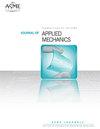Thermomechanical Coupling in Polydomain Liquid Crystal Elastomers
IF 2.8
4区 工程技术
Q2 MECHANICS
引用次数: 0
Abstract
Liquid crystal elastomers (LCEs) are made of liquid crystal molecules linked into rubber-like polymer networks. An LCE exhibits both the thermotropic property of liquid crystals and large deformation of elastomers. It can be monodomain or polydomain in the nematic phase and transforms to an isotropic phase at elevated temperature. These features have enabled various applications of LCEs in robotics and other fields. However, despite substantial research and development in recent years, thermomechanical coupling in polydomain LCEs remains poorly studied, such as their temperature-dependent mechanical response and stretch-influenced isotropic-nematic phase transition. This knowledge gap limits the fundamental understanding of the structure-property relationship, as well as future developments of LCEs with precisely controlled material behaviors. Here we construct a theoretical model to investigate thermomechanical coupling in polydomain LCEs, which includes a quasi-convex elastic energy of the polymer network and a free energy of mesogens. We study working conditions where a polydomain LCE is subjected to various prescribed planar stretches and temperatures. The quasi-convex elastic energy enables a “mechanical phase diagram” that describes the macroscopic effective mechanical response of the material, and the free energy of mesogens governs their first-order nematic-isotropic phase transition. Evolution of the mechanical phase diagram and the order parameter with temperature is predicted and discussed. Temperature-dependent mechanical behaviors of the polydomain LCE that have never been reported before are shown in their stress-stretch curves. These results are hoped to motivate future fundamental studies and applications of thermomechanical LCEs.多畴液晶弹性体的热机械耦合
液晶弹性体(LCE)是由连接成橡胶状聚合物网络的液晶分子制成的。LCE既表现出液晶的热致性,又表现出弹性体的大变形。它可以是向列相中的单畴或多畴,并在升高的温度下转变为各向同性相。这些特性使LCE能够在机器人和其他领域中进行各种应用。然而,尽管近年来进行了大量的研究和发展,但对多畴LCE中的热机械耦合的研究仍然很少,例如其温度相关的机械响应和拉伸影响的各向同性向列相转变。这种知识差距限制了对结构-性能关系的基本理解,以及具有精确控制材料行为的LCE的未来发展。在这里,我们构建了一个理论模型来研究多畴LCE中的热机械耦合,该模型包括聚合物网络的准凸弹性能和介晶元的自由能。我们研究了多畴LCE受到各种规定的平面拉伸和温度的工作条件。准凸弹性能使得“机械相图”能够描述材料的宏观有效机械响应,并且介晶的自由能控制其一阶向列各向同性相变。预测和讨论了机械相图和阶跃参数随温度的演化。在它们的应力-拉伸曲线中显示了以前从未报道过的多畴LCE的温度相关力学行为。这些结果有望激励未来热机械LCE的基础研究和应用。
本文章由计算机程序翻译,如有差异,请以英文原文为准。
求助全文
约1分钟内获得全文
求助全文
来源期刊
CiteScore
4.80
自引率
3.80%
发文量
95
审稿时长
5.8 months
期刊介绍:
All areas of theoretical and applied mechanics including, but not limited to: Aerodynamics; Aeroelasticity; Biomechanics; Boundary layers; Composite materials; Computational mechanics; Constitutive modeling of materials; Dynamics; Elasticity; Experimental mechanics; Flow and fracture; Heat transport in fluid flows; Hydraulics; Impact; Internal flow; Mechanical properties of materials; Mechanics of shocks; Micromechanics; Nanomechanics; Plasticity; Stress analysis; Structures; Thermodynamics of materials and in flowing fluids; Thermo-mechanics; Turbulence; Vibration; Wave propagation

 求助内容:
求助内容: 应助结果提醒方式:
应助结果提醒方式:


